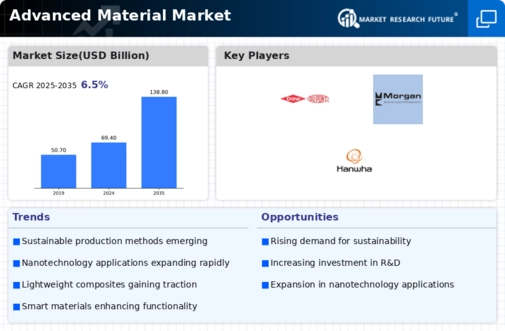Market Trends
Key Emerging Trends in the Advanced Material Market
A lot of research and development is leading to a lot of new technologies coming out in the Advanced Material Market. Biotechnology, nanotechnology, and mixed materials are all making progress that will help make new materials that are better in how they work and what they can do. Energy efficiency and environmental friendliness are growing, so lighter materials are needed more in many areas, like electronics, cars, and planes. There are more and more uses for new materials like carbon fiber composites and high-strength metals as companies try to make things lighter without lowering their strength. The business is moving toward eco-friendly methods and goods that will last because they care about the earth. Bio-based goods, recycled plastics, and other environmentally friendly choices are becoming more popular as businesses try to meet global sustainability goals. The tech business needs more improved materials because there are so many smart gadgets out there. People are using graphene, conductive polymers, and other new materials because of their unique electrical and heat properties. These qualities help make computer parts that work faster and better. 3D printing lets people make complicated and unique parts, which is changing the way things are made in a big way. 3D printers can make high-performance plastics and metal materials that are being used by more and more people. These new materials give designers and makers more ways to make things. Medical gadgets, implants, and drug transport systems are all using more and more modern materials. Biomaterials and smart materials are very important for making medical goods work better and be compatible with living things. Using smart materials that can respond to changes in their surroundings is becoming more popular in many fields. Innovative uses are being considered for shape-memory metals, magnetic materials, and self-healing plastics because they can change and adapt to new situations. The market for modern materials is growing a lot in the Asia-Pacific area. This is because more people are becoming industrialized and building up infrastructure. China and India are becoming bigger players in the market. They buy and sell a lot of goods. There are more and more smart relationships and collaborations between businesses so that they can use their skills to help each other and make the development of new goods go faster. Material makers, study institutions, and end users are working together to create a joint environment that encourages new ideas and market growth. Even though the trends are positive, problems like supply chain delays and managing costs still exist. Prices of raw materials that go up and down and political issues in other countries can change the cost structure. To stay competitive in the market, businesses need strong supply chain plans.


 Source: Secondary Research, Primary Research, Market Research Future Database and Analyst Review
Source: Secondary Research, Primary Research, Market Research Future Database and Analyst Review



Leave a Comment